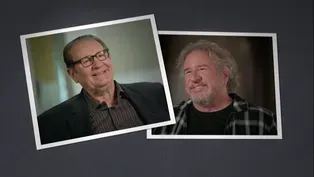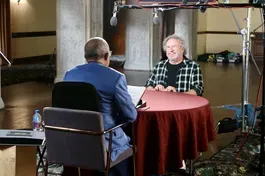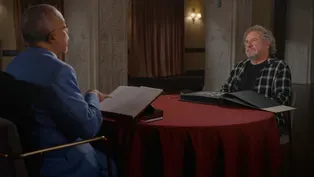Finding Your Roots
Ed O'Neill Learns About His Immigrant Ancestor's Harsh Start
Clip: Season 10 Episode 4 | 7m 36sVideo has Closed Captions
Ed O'Neill's maternal ancestors migrated from Ireland escape the Great Potato Famine.
Ed O'Neill's maternal ancestors migrated from Ireland to Youngstown, Ohio, in the 1800s to escape the Great Potato Famine. They worked as coal miners, enduring harsh conditions underground.
Problems with Closed Captions? Closed Captioning Feedback
Problems with Closed Captions? Closed Captioning Feedback
Corporate support for Season 11 of FINDING YOUR ROOTS WITH HENRY LOUIS GATES, JR. is provided by Gilead Sciences, Inc., Ancestry® and Johnson & Johnson. Major support is provided by...
Finding Your Roots
Ed O'Neill Learns About His Immigrant Ancestor's Harsh Start
Clip: Season 10 Episode 4 | 7m 36sVideo has Closed Captions
Ed O'Neill's maternal ancestors migrated from Ireland to Youngstown, Ohio, in the 1800s to escape the Great Potato Famine. They worked as coal miners, enduring harsh conditions underground.
Problems with Closed Captions? Closed Captioning Feedback
How to Watch Finding Your Roots
Finding Your Roots is available to stream on pbs.org and the free PBS App, available on iPhone, Apple TV, Android TV, Android smartphones, Amazon Fire TV, Amazon Fire Tablet, Roku, Samsung Smart TV, and Vizio.
Buy Now

Explore More Finding Your Roots
A new season of Finding Your Roots is premiering January 7th! Stream now past episodes and tune in to PBS on Tuesdays at 8/7 for all-new episodes as renowned scholar Dr. Henry Louis Gates, Jr. guides influential guests into their roots, uncovering deep secrets, hidden identities and lost ancestors.Providing Support for PBS.org
Learn Moreabout PBS online sponsorshipWe'd already explored Ed O'Neill's paternal roots, showing how his grandfather was shaped by the brutal world of the steel industry.
Now, turning to Ed's mother's family tree, we found ancestors who were forced to confront a world that was even more brutal.
The story begins with Ed's third great-grandparents, Bridget and James Tyrrell.
Bridget and James were born in Ireland in the early 1800s and left their native land sometime after 1849 with seven children in tow, fleeing starvation and the horrors of what became known as the Great Potato Famine.
By 1860, the family had settled in Ed's hometown, Youngstown, Ohio, where a new set of challenges awaited them.
What are their occupations?
- Coal miner.
- Coal miner.
- Yeah.
- And 17-year-old coal miner.
- Yes, yes.
- Yeah.
James is a coal miner.
Bridget's taking care of the children.
- Yeah.
- And son Thomas, who's only 17 years old, has already started working in the mines.
- In the mines.
- Alongside his father.
- Did you know that?
- No.
That you had coal in your blood?
No.
What do you imagine that was like, Ed?
I've never been in those mines.
Hmm, I would never want to go- I don't know what they look like, and I don't want to go down underneath the ground.
When Ed's ancestors arrived in America, Ohio's coal industry was booming, but the workers who actually had to go into the mines faced a terrifying task.
Laboring more than a thousand feet beneath the earth, breathing in clouds of coal dust, constantly fearing that the walls around them would collapse.
And look how young they are.
Those faces, most of them are young.
Yeah.
Yep, they didn't do it for their health.
Mm-mm, James and 17-year-old Thomas likely took an elevator down the mining shaft and mined the coal by hand using picks and shovels.
Yeah.
And Thomas is just one year older, Ed, than your daughter Claire.
Think about that for a minute.
Can you imagine sending Claire off to the mines to support the family?
No, no, no.
How do you think they felt about their new country?
Well, they were probably eating- Mm-hmm.
You know, so they probably liked that part of it.
Yeah, I mean, I guess you do what you have to do.
Whatever comforts the Tyrrells found in America did not last for long.
In 1861, a year after we saw them in the Ohio census, their new nation was engulfed by civil war.
James and Bridget were in their fifties, but they had three sons, all teenagers, and in August of 1862, their oldest boy, Thomas Tyrrell, appeared on a muster roll for an Ohio infantry regiment.
- Unbelievable.
- Thomas volunteered.
He volunteered to serve in the Union Army.
He was just 19 years old, a teenager.
And what do you think your third great grandmother, Bridget, thought?
She was watching her child head off to fight in a war in a country she just moved to.
That would be rough.
I mean, 19, he was just a boy a few years before that.
Yeah.
19 is a boy.
19 is a boy.
Yeah.
Thomas was given little time to grow up.
Just two months after volunteering, his regiment was thrust into a battle at Chaplain Hills, Kentucky, where more than 70,000 soldiers fought over a small network of roads outside the town of Perryville.
Look at that.
More than 7,500 casualties were suffered making it one of the bloodiest battles of the entire war.
Wow.
Relative to the size of the armies involved, sort of per capita.
Yeah.
So how did Thomas fare, do you think?
I want you to guess.
Well, I would say it's a crapshoot.
Yeah.
He was probably not trained that much, right, I mean- - No.
- He was just right thrown in.
And we went in in August, this is October.
Well, then you just, you're either lucky or you're unlucky.
Yeah, well, let's see, which was for Thomas.
This is another military record dated February 21, 1863.
Would you please read the transcribed section.
"I certify that I have carefully examined the said Thomas Tyrrell and find him incapable of performing the duties of a soldier because of gunshot wounds in right shoulder leaving him with stiff joint and almost useless arm.
Degree of disability, two-thirds."
Oh my God.
Thomas was discharged in February of 1863 with a permanent disability, and this wasn't the end of his family's ordeal.
One year later, his brother James followed him into the army and soon found himself hospitalized with a heart condition.
Ed wondered how the boys' parents must have felt, waiting at home wondering if their sons were hurt or captured, dead or alive.
But as it turns out, their mother wasn't at home.
Records show that by the fall of 1864, Bridget Tyrrell was serving in the Union Army as a nurse, one of roughly 20,000 women who volunteered to aid the Northern cause.
And in many cases, these women just showed up and did whatever they could to help.
They got tired of sitting around and having all that anxiety.
I mean, I would love to have been a fly on the wall when she decided to go.
Yeah.
And say, "Where are you going?"
Right.
"You're doing what?
You're not doing that."
- How are you getting there?
- Yeah.
You're going through- - Yeah.
- War places.
- That's right.
- Unbelievable.
Bridget tended to the wounded in what was known as Brown Hospital in Louisville, Kentucky.
There's no evidence that she had any medical training at all, but that likely didn't matter, as reports suggest the hospital was desperate for whatever help it could get.
"The sick are sent to the general hospitals in and about Louisville.
Brown Hospital has received most of the patients from the army.
This hospital is entirely too much crowded for its capacity and number of surgeons and nurses.
The patients have not been able to receive the attention they should."
- That's where she worked.
- Oh my God.
At the hospital where Bridget worked- - What is that?
- That's it.
Oh my God, it's like a shack!
That is Brown- - It's an elongated shack!
- That is Brown Hospital, man.
Oh my God.
Can you imagine how it- It doesn't look like any hospital I ever saw.
Imagine how it smelled.
Just like, start with that.
God.
She probably watched a lot of men die.
- Oh yeah.
- Every day.
Yeah, big time.
Geez, that's something.
As a Boy, Ed O'Neill Acted Out Movie Scenes for Friends
Video has Closed Captions
Ed O'Neill caught the acting bug by re-enacting movie scenes to his childhood friends. (1m 8s)
Video has Closed Captions
Henry Louis Gates, Jr. helps Sammy Hagar & Ed O’Neill discover deep family secrets. (31s)
Sammy Hagar Discovers His True Biological Surname
Video has Closed Captions
Sammy Hagar's DNA test results show he doesn't genetically belong to the Hagar lineage. (7m 20s)
Sammy Hagar Tears Up Over His Mother's Hard Life
Video has Closed Captions
Reflecting on his mother's difficult upbringing moves Sammy Hagar to tears. (1m 13s)
Providing Support for PBS.org
Learn Moreabout PBS online sponsorshipSupport for PBS provided by:





















